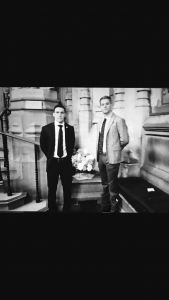Guy Cheatham
London School of Economics
London, England
Fall 2016
Remembering and Commemorating John Hampden
I have taken the tube several times to Westminster. I have walked down the Southbank numerous times over to this area. The bridge is swarmed by workers, students, tourists, and double-decker buses, as individuals look over the bridge to see the magnificence that is the historic House of Parliament. I look at the British government’s legislative headquarters and wonder what goes on inside, considering the intense political climate resulting from Theresa May’s push to trigger Article 50 and have Britain say farewell to its membership of the European Union. Luckily I was given the opportunity to find out.
Three-hundred and seventy-five years ago England was engaged in a bloody civil war, as Charles I’s power and legitimacy as king hung in the balance. Charles contested with Parliament early on in his reign, since he believed that the legislative body sought to curb his royal prerogative, and as a firm believer in the divine right of kings, he was confident in being able to govern under his own judgment. His policies were strongly disapproved by many of his subjects, considering said policies to be characteristic of a tyrannical absolute monarch. Disapproval came from the House of Parliament, among the leaders in the challenge to Charles’ rule being John Hampden. This disapproval stemming from the King’s subjects and Parliament resulted in the English Civil War, ending in the execution of the tyrannical king and the rise of Oliver Cromwell. Three-hundred and seventy-five years after this bloody conflict in which Hampden was lionized for, I was given the opportunity to take part in a ceremony commemorating his efforts to defeat a tyrannical monarch.

Adrian and I walk into the House of Parliament on a cold Tuesday morning in Westminster. We were accompanied by the Earl of Buckinghamshire (descendant of Hampden), some of his colleagues, and two MPs (Parliament members). We make our way into Westminster Hall, one of the most historic rooms in the House of Parliament, as we were walking through the very room that Charles I was sitting in over three centuries earlier before the High Court of Justice, being sentenced to death for making war on Parliament and the people of England. Following the tour of Westminster Hall, came the wreath laying ceremony for John Hampden. Adrian and I were asked to lay the wreath before his statue in St. Stephen’s Hall, marking the commemoration of the stance Hampden took against tyrannical rule for the people of England. Following the ceremony, we were given the privilege to walk through the House of Commons and the House of Lords. The House of Commons is certainly much smaller and a more intimate setting than I expected, making it difficult to visualize how hundreds of MPs can fit into this small chamber. The House of Lords is a fascinating chamber as well, especially The Queen’s chair, covered in pure gold. Overall the experience in the House is an experience I will never forget. It is an intense political environment rich in history, and I am glad that I was able to be a part of its magnificence.

Many thanks to Dr. Widdows and the Earl of Buckinghamshire for setting up this opportunity for Adrian and myself.